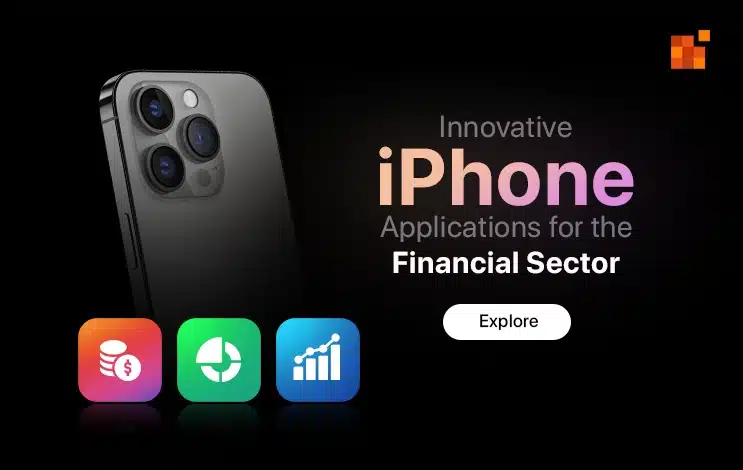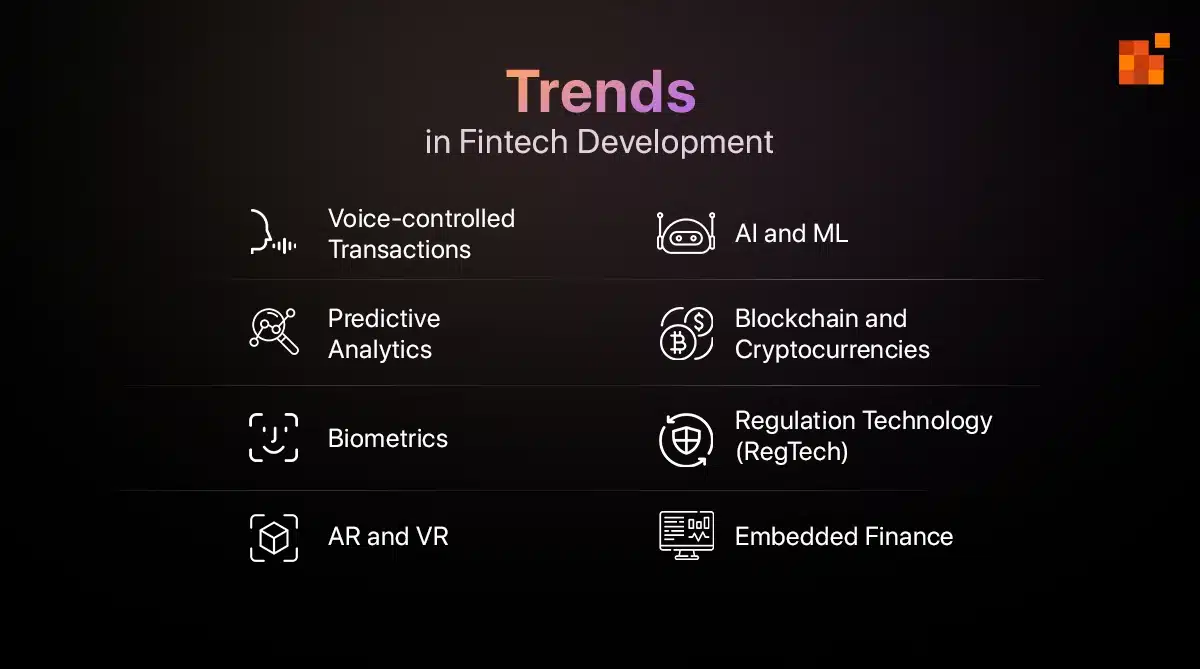Fintech Landscape: Overview and Evolution
Remember the electronic banking systems that were introduced in the late 90s and early 2000s? It marked the advent of the fintech era.
This first step laid the foundation for the growth and expansion of this industry. The industry moved to P2P lending platforms and then advanced to mobile payments.
Did you know? 73% of millennials in India use FinTech apps to budget, invest, and track their finances. Are you missing out on the revolution?
Today there are products such as digital insurance and digital securities that are helping the industry transform and mature.
The rapid technological advancements and newer needs expressed by the users are helping shape the industry.
As people demand user-friendly interfaces and tailored solutions, the products use AI and data analytics to create value. it has also led to the growth of iOS app development services globally.
With tech advancements like DeFi platforms and AI integration, you must approach the Fintech development strategically.
The rise in DeFi platforms and AI integration will contribute to Fintech growth in the coming era.
Let’s look at the top apps revolutionizing the financial technology industry.
Top 5 Apps in the Fintech Industry
Several apps have revolutionized the industry as we knew it. It helped disrupt the industry, innovate segments and unleash exceptional solutions.
1) Square Cash
This is one of the top mobile payment systems available in the United States and United Kingdom markets. It facilitates peer-to-peer transactions too. It also comes with a cash card that allows you to make retail purchases and ATM withdrawals.
2) Venmo
If you want to make small payments with your phone, this is your application. You can also share the payment activities with your social group using this application. It is also a great app that facilitates bill splitting for easier group payments.
Ever wondered how much those handy bill-splitting apps cost to build? Don’t miss our post for a detailed cost breakdown and valuable insights to guide your fintech app development journey.
3) PayPal
This is your popular digital wallet that has enabled fast online transactions. You can use it as your business account to receive money for the work done. It is the best fit for all types of international transactions.
4) Robinhood
It is used for commissionless stock trading. With a user-friendly interface, it makes trading smooth and seamless. Moreover, it incorporates all types of trading options, including cryptocurrencies.
5) Mint
With expenses skyrocketing each year, you must look for spending tracker applications. Mint is one such application that will help save money. This is one of the finest iPhone apps for finance that makes your expense management seamless.
Current Trends of Fintech Development
When planning a building finance app, you must be up-to-date with the current trends dominating the industry. We have accumulated a list of these trends that you must know.
1) Voice-controlled Transactions
Accessibility is the key to enhancing your user’s experience. Voice-controlled transactions can help people access financial applications with their voice. As a result, users with disabilities or motor issues can easily access the fintech application. It is also a great way to use the application while commuting or otherwise.
2) Predictive Analytics
If you want to succeed with your financial technology application, you must offer products and services aligned with your user. Predictive analytics use AI and ML algorithms to understand past trends, historical behavior and customer behavior to predict the industry’s future.
Using these insights, the applications can tailor the financial recommendations, offer risk assessments and widen the offering.
3) Biometrics
When you are dealing with the financial segment, you need to impose the highest level of security. This can occur when you use the best security protocols and solutions.
Biometrics can help improve authentication methods and enhance your security solutions. You can use facial recognition, iris or fingerprint scans to implement the best security.
Moreover, it offers easy access to the application and enhances the user’s experience.
4) AR and VR
Immersive experiences can capture your user’s attention and engage with them. As a result, you can use AR and VR to improve data visualization and virtual attendance. Your fintech user can view their bank branches and other real environments in the virtual scape.
It will help them interact with the service better and lead to excellent outcomes.
5) AI and ML
Artificial Intelligence with Machine Learning can help banks and financial institutions enable better fraud detection. It can also enhance credit scoring and automate customer service solutions.
This will help your financial institution be more productive and enhance its abilities. You can also accelerate routine tasks to enable better services.
6) Blockchain and Cryptocurrencies
Blockchain is pivotal as more companies want to secure their transactions and improve transparency. The integration with cryptocurrencies can help decentralize transactions, speed them up and improve asset accessibility.
7) Regulation Technology (RegTech)
You can use this technology to improve regulatory compliance. It is used to streamline/automate the processes. You can also use this trend to assess and mitigate the risks in this segment. Moreover, it can help you stay productive when it comes to compliance.
8) Embedded Finance
More businesses are continuously integrating financial services into their non-financial counterparts. This will help financial businesses expand their services and improve accessibility. This trend will see an upward growth in social media and eCommerce.
Most of these financial technology applications have been devised for iOS and Android. However, it cannot be negated that Apple has played a pivotal role in shaping the fintech industry. Apple Pay, Card and Watch are some of the significant solutions in the iOS world.
If you plan an iOS-first strategy, you can leverage the ecosystem and build innovative products/services.
Why Build iOS-first Fintech Apps?
So, why should you build an iOS-first Fintech application? We have identified the benefits that can help you leverage the Apple world better.
1) Integration with Apple Ecosystem
When you design an iOS application, it can seamlessly integrate with the Apple ecosystem. The product will work on iPhones, iPads and Watches extending the same consistency and experience. As a result, you can drive better engagement that translates into retention and loyalty.
2) Security
Apple is renowned for the capable security it offers to its users. The in-built end-to-end encryption offers better authentication and protection abilities.
The users on Apple feel that their data is safe and transactions are confidential. This is exceptionally crucial for your users.
3) Advanced capabilities
Apple is known to integrate with the latest hardware and software solutions. The ecosystem extends advanced capabilities using cutting-edge technologies. You can leverage the latest tech trends, such as AR and ML to develop excellent applications.
You can introduce the best functionality in the applications for your business.
4) Stringent Reviewing
Apple is known to possess a stringent process to review the application quality. Your apps need to meet the high standards defined by the application. This will include speed and performance. As a result, you will always release applications that are credible and trusted.
5) High Spending Power
When creating applications for iOS users, you attract a premium audience. They are more likely to spend on in-app purchases. Moreover, they would invest in exclusive features, thus increasing the bottom line.
6) Tech-Savvy Users
One of the biggest reasons to develop apps for iOS would be the users. You will be working around tech-savvy users ready to invest in the technology. They would adopt the new application and embrace innovation. This means you are getting a ready user base with the Apple ecosystem.
7) Developer Tools
The ecosystem is huge and supportive. You will find the tools and frameworks complete with the latest technologies and productivity-aiding solutions. This can improve the development cycle and accelerate time-to-market.
The Challenges & Considerations of Going iOS-First
When planning an iOS-first fintech application, you might face several challenges. Apple as an ecosystem may not cover all your objectives. Here are a few challenges that you are likely to face.
Challenges with Going iOS-first
- The narrow market for iOS is a limitation. While they spend more, you are working around a smaller market share. This would restrict your reach to markets where Android is the dominant player. Moreover, you may need help to connect with the real users of your application.
- You may not be able to access the consumers of an Android-dominant market. Your visibility and availability will be stuck to iOS markets. This can lead to the loss of real users.
- The approval process is slow and long. You might need to work around stringent policies. This can be challenging, especially when you are working with Fintech applications. In this case, you must ensure the app meets the Apple guidelines and the requisite compliances.
- You must work around the limited ecosystem developed by Apple. You cannot integrate your application with third-party applications or solutions.
- As your design must adhere to the rules defined by Apple, you cannot customize or innovate your application.
- The development time or costs are high when you plan the application for Apple’s ecosystem. You must define timelines for financial regulations, security protocols and regulatory compliances. You might need to invest in resources for defining the application with rigid security.
- The user acquisition costs can pose a challenge to the Apple ecosystem. You might need to invest more when acquiring customers or planning the marketing.
Considerations for Going iOS-first
When going iOS-first with your fintech development, you must consider a few aspects. Let us list it out for you.
- It is important to consider demographics and target audience for your fintech application. If your target market prefers iOS, you can build an iOS-first strategy.
- Check if iOS is the dominant operating system for the market you are observing. This should include all the target regions.
- If you have a lot of sensitive information and data on the platform, you must invest in robust security measures. It can improve the app’s outcome.
- Choose iOS for application development if your budget can accommodate the high user acquisition costs. To ensure the budget is aligned with your costs, you must also weigh the benefits.
- The iOS development cost is also relatively higher. This is because you need to hire premium resources for design, development and testing. Moreover, you need to pay for the tools and deployment.
- Look at the maintenance and support extended by the platform to make the right choice for your fintech solution.
Best Practices for Developing User-centric Fintech Applications
When you want to build user-centric Fintech applications, you can implement these best practices.
- Identify the financial requirements of your user base. A thorough research would help identify the pain points, preferences and requirements in detail.
- It is important to incorporate a smooth and streamlined onboarding process. This will help improve the app’s usability for the new users. You can also improve access via clear instructions.
- Develop an intuitive interface and navigation. Make your app’s platform simple and usable for better experiences.
- Identify your user’s requirements and their behavior on the application. Use the data to build a more personalized application that includes notifications and insights tailored to them.
- Make sure to introduce transparency in the financial transactions. Include histories regarding the data and amount for better solutions.
- Make sure to implement robust security solutions for authentication and transactions. You must communicate the security protocols to your user to maintain clarity.
- Inclusivity and accessibility are the two pillars of success for your application. Ensure you have implemented the strategies such as voice-operated transactions for better access. This would ensure people with disabilities such as visual impairments, motor issues, and others can use the application.
- Implement methods that can help you complete the transactions with ease. You can incorporate effortless methods such as one-click payments for ease.
- You must continuously improve the application. You can fix the bugs, incorporate user feedback and enhance security. This would streamline the experience.
- In-app notifications can help your users stay aware of their financial activities. It would also help them gain relevant information.
- Ensure offline app availability for users to complete transactions without the Internet.
Future of Fintech
The future of financial apps is marked by integration with advanced technologies and continuous improvement.
- Decentralized Finance will notice an upward graph as more businesses use it for lending, borrowing and trading activities. You will notice better security features owing to Blockchain and smart contract implementation.
- Using open banking, you can improve the collaboration between financial institutions and third-party applications. You can use APIs for seamless activities and secure data solutions.
- Digital identity solutions will see more inclusion in the fintech applications. This will help secure the transactions and the overall app usage.
- Sustainable financial applications will see growth. Businesses must ensure the apps are aligned with the ESG (Environmental, Social and Governance) factors.
- Quantum computing will be used to complete complex financial modeling and improve the risk analysis. It will help develop quantum-ready interfaces.
Conclusion
Fintech is indeed unraveling the future of the financial sector one tap at a time. Leveraging current trends, innovative narratives, and user-centric services, the industry is dynamically evolving.
Apple has played a pivotal role in shaping this industry with robust security and advanced functionality. Most businesses opt for iOS-first strategies to acquire premium users, enhance credibility and maximize returns.
However, iOS-first Fintech development has its limitations in terms of customization and ecosystem integration. We have discussed the best practices for the iOS-first app strategy.
The fintech-iOS blend can help develop a user-friendly and accessible mobile application. To embrace the continued evolution of the Fintech industry, you must partner with a capable Fintech app development partner.
Best Remote Team can identify and help collaborate with the right resources to establish and grow your fintech business. If you want to discuss iOS-first strategies or hire an iOS app developer for your project, connect with us today.


